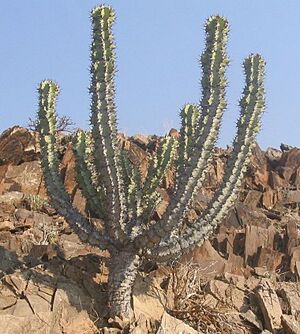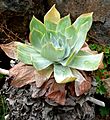Xerophyte facts for kids
Xerophytes are amazing plants that have learned to live in very dry places, like deserts. Think of them as nature's survival experts! They are often a type of succulent plant, which means they can store water. To survive in tough, dry conditions, these plants have special tricks. For example, a cactus has white hairs that help it save water. Also, manzanita plants have a thick, waxy coating and keep their leaves pointing up to the sun to avoid too much heat.
Contents
How Xerophytes Survive Dry Places
Some xerophytic plants are super patient. They can simply wait out a drought (a long period without rain). Even when it's dry, they can still pull water from the soil. Some have very salty sap inside their cells, which helps them draw in even tiny bits of water. Others have very long or deep roots to find water far underground. They might even survive by collecting the smallest bit of morning dew!
Special Features of Xerophytes
Many xerophytes have unique shapes or structures that help them survive. These are called xeromorphs. Here are some cool examples:
- Thick Waxy Coating: Plants like Aloe have a thick, waxy layer on their leaves. This is like a natural raincoat that stops water from evaporating.
- Hairy Surfaces: Plants such as Edelweiss have fuzzy or hairy leaves. These hairs trap a layer of moist air close to the plant, reducing water loss.
- Small or Packed Leaves: Some cypress species have tiny leaves that are packed closely together. This reduces the surface area exposed to the sun, so less water is lost.
- Fewer Stomata: Many cacti have fewer stomata (tiny pores on leaves that let plants "breathe" but also lose water). This helps them save water.
- Hidden Stomata: Some plants, like Ammophila, have their stomata hidden in pits or grooves. This also helps reduce water loss.
- Water Storage: Plants like the baobab tree can store a lot of water in their stems or roots (called tubers). They might even protect this stored water from animals using spines or special chemicals.
Clever Ways Xerophytes Stay Hydrated
Here's a table showing some of the amazing ways xerophytes manage to find and keep water:
| How They Do It | What They Have | Example |
|---|---|---|
| Limit Water Loss | Waxy leaves or stems | prickly pear |
| Few breathing pores (stomata) | Many cacti | |
| Stomata hidden in pits | pine | |
| Stomata open only at night | tea plant | |
| Special photosynthesis (CAM) They collect CO2 at night when stomata are closed during the day. | Cactus | |
| Large hairs on their surface | bromeliads | |
| Curled leaves | esparto grass | |
| Store Water | Thick, juicy leaves | Kalanchoe |
| Fleshy stems | Euphorbia | |
| Fleshy underground tubers | Raphionacme | |
| Take Up Water | Very deep roots | Acacia, Prosopis |
| Roots reach the water table | Nerium oleander | |
| Absorb moisture from air with leaf hairs | Tillandsia |
Images for kids
-
The succulent leaves of Dudleya brittonii are covered in a white, powdery wax.
-
Dudleya pulverulenta is called 'chalk lettuce' because of its chalky wax coating and fleshy leaves.
-
Agave americana is a useful xerophyte. People use it for decoration, food, and traditional medicine.






